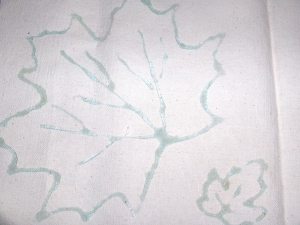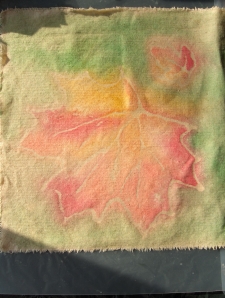This is a project I did a couple years ago as a table runner for Fall and for our Thanksgiving table.
I found the idea for this in the October issue of one of my favourite magazines “Family Fun”. Here is a link to the instructions on their website if you would like to see the original. http://familyfun.go.com/magazine/familyfun-magazine-archive/familyfun-october-2009/glue-batik-banner-785331/
Earlier today, coincidentally, I was going through some of my blog feeds on my reader and found a new blog I had not seen before. It’s a wonderful site run by a teacher and artist and she gives all kinds of art ideas and techniques there. They are suggested for use with children of various ages but many of them would be quite enjoyable for adults as well. It turns out that this glue batik technique was featured on her blog as well. She had tried it with one glue first but then tried it with the Elmer’s glue suggested below and she said that it produced the best results. Here’s the link to her blog posts on it:
http://thatartistwoman.blogspot.com/2008/07/kid-friendly-batik.html
http://thatartistwoman.blogspot.com/2008/09/how-to-do-fall-glue-batik.html
The supplies you need are: a suitable piece of fabric (I used a scrap of plain canvas material that I had lying around – they suggested using something like a muslin or an old piece from a bed sheet), acrylic craft paints in the colours you would like to use, washable glue (they suggested Elmer’s Washable Gel Glue – it’s a blue gel glue and it worked very effectively and is highly recommended by the second website I found using this technique), paintbrushes (one of them should be a wide brush), plastic wrap/waxed paper/or a plastic garbage bag, something to use for holding the paints and water (they suggested a foam plate or styrofoam tray but I used some cleaned out yogurt cups), and a pail or basin to soak the fabric in.
I decided to follow the example shown in Family Fun magazine and make this a fall leaf banner. I used actual leaves like they did as the patterns but you could do the same with anything! The person on the blog I found today lightly pencilled in a design and used that but you could certainly find a pattern and make a template to use instead. If you would like to make yours with fall leaves as well, I found a template for some here:
http://www.chicaandjo.com/wp-content/uploads/2009/11/Chica_And_Jo__Leaf_Template.pdf
In the magazine, they suggested tearing the fabric to size as the frayed edges then don’t need any hemming and it adds a nice natural look to the banner that I think suits the muted, washed out look of the painting. Place the fabric on the waxed paper/plastic wrap/or a garbage bag to protect the surface you are working on. I laid the leaves out in a pleasing design on the fabric. Then, using the blue gel glue, use it to trace around each of the leaves. Also use the gel to add some veining lines to the leaf patterns if desired.
You need to leave this to dry completely. Family Fun suggested 24 hours while the blog said 12. I did it for the 24 and would think that’s best just to be safe. Once completely dry, begin by wetting down the fabric by painting water onto it with the wide paintbrush. (Again make sure you have this laying on a the protective surface as before. This is going to get wet and could be messy! Also, I found it was important to keep a cloth or some paper towels or something like that nearby to sop up any excess water.) Now’s the time to begin adding the paints. Squirt out a bit of each colour you are using (I used a red, orange, and yellow for the leaves and a green for the background) and thin it down with a little water. Start by painting your main design first and then go on to the background. Because the fabric is wet and the paints are diluted, as you brush them on, they will flow together a bit the way that watercolours do.
After you have finished painting the main design (the leaves in my case), continue adding paint to the background in the same manner.
Once you have the banner (or whatever you are making!) completely painted, leave it to dry for a couple of hours. When it’s dry, fill the pail or basin with some warm water (Family Fun says warm so that’s what I used but on the blog, she suggested that it should be really warm…nearly hot) and place the fabric in there to soak for 20-30 minutes. (The blog says 10-30 minutes).
Now, you need to remove the fabric from the water and begin to rub away the glue lines. The instructions said “rub” but I found that I actually needed to use my nail and gently scrape it a bit to get it off. Again, you may want to have a cloth or paper towels nearby because I found that the glue kind of “built up” on my fingers and I needed to clean them off from time to time. I also worked near the sink so that I could rinse my fingers off occasionally. Removing the glue will reveal the plain cloth underneath.
Once you have removed all the glue, rinse the fabric in plain water to remove any last traces of it and lay the fabric out flat to dry. The directions suggest you may want to go on to iron this but I don’t have an iron available at the moment and I quite like the rumpled look of this. I think it goes along with the faded paints and torn edges. The Family Fun website suggests a way of finishing off the banner gluing it to a stick at the top and then adding yarn or string as a hanger from the stick. You can finish this in any way you would like. I can see this being made into far more than just banners – pillows, placemats, table runners, even Christmas stockings and more!









Jane T says
Thanks for the great directions. Maybe this is like painting on fabric. I am going to save these directions. I wonder if you could apply the glue with something like a Qtip to get a kind of uneven edge in the veins. Thanks.